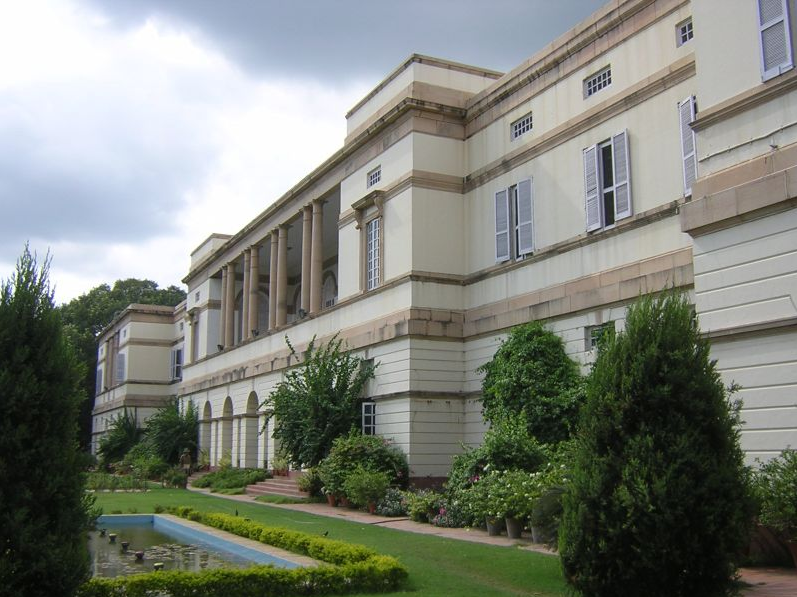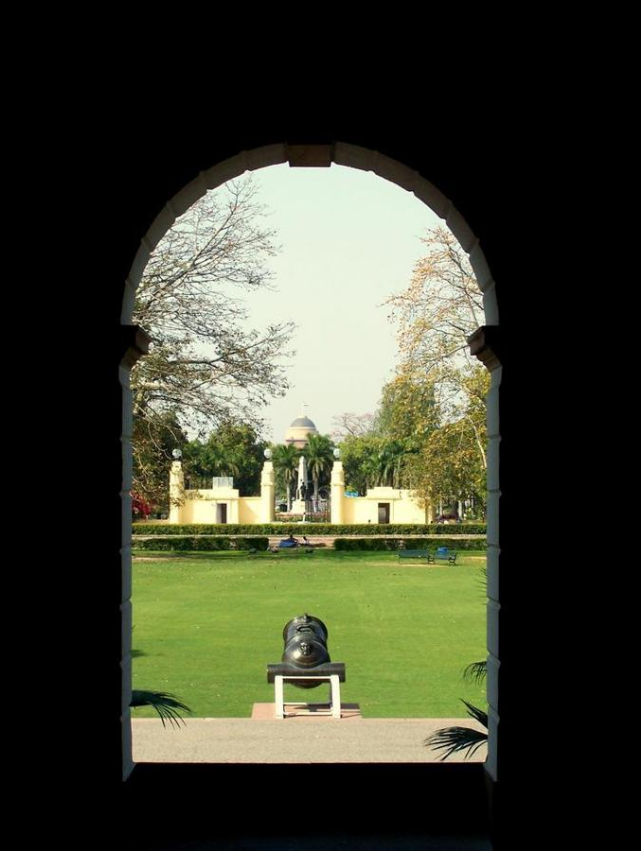
| Version | Summary | Created by | Modification | Content Size | Created at | Operation |
|---|---|---|---|---|---|---|
| 1 | Sirius Huang | -- | 1046 | 2022-11-11 01:38:01 |
Video Upload Options
The Nehru Memorial Museum & Library (NMML) is a museum and library in New Delhi, India , which aims to preserve and reconstruct the history of the Indian independence movement. Housed within the Teen Murti House complex, it is an autonomous institution under the Indian Ministry of Culture, and was founded in 1964 after the death of India's first prime minister, Jawaharlal Nehru. It aims to foster academic research on modern and contemporary history. Today, the Nehru Memorial Library is the world’s leading resource centre on India’s first prime minister. Its archives contain the bulk of Mahatma Gandhi's writings, as well as private papers of C. Rajagopalachari, B. C. Roy, Jayaprakash Narayan, Charan Singh, Sarojini Naidu and Rajkumari Amrit Kaur. In March 2010 it launched a digitization project of its archives, and by June 2011, 867,000 pages of manuscripts and 29,807 photographs had been scanned and 500,000 pages had been uploaded on the digital library website. Amongst noted publications of the NMML are Selected Works of Jawaharlal Nehru, Man of Destiny by Ruskin Bond, Nehru Anthology (1980) and Nehru Anthology. Nehru Memorial Museum & Library has over the years supported scholars and historians across India. Through its fellowship programme, the Nehru Memorial Fellowship, it has funded some of India’s best academics such as Chief Information Commissioner OP Kejriwal. It is also one of the best libraries in Delhi for the social sciences as it has a huge collection on labour related issues in the form of PhD dissertations, reports, books, journals and news papers. On 26 April 2016 a dagger gifted to former prime minister Jawaharlal Nehru by Saudi Arabia was stolen from the Nehru Memorial Museum and Library.
1. Overview

Nehru Memorial Museum and Library is known as Teen Murti Bhawan (sculptor: Leonard Jennings of Britain), after the three statues established in 1922 in honor of the three Indian princely states Jodhpur, Hyderabad and Mysore after their contribution in World War I by serving in the present day Gaza Strip, Israel, and Palestine. It was designed by Robert Tor Russell who also designed Connaught Place and a few parts of Janpath. Spread over 30 acres, its construction started in 1929 and took around one year to completion. It is a masterpiece of British and French architecture and woodwork. Initially knows as Flagstaff House, it was used by British forces as the residence of the Commander-in-Chief. After Independence, the house was taken over as the residence of Jawaharlal Nehru (1889–1964), first Prime Minister of India. After his death in 1964, it was decided that Teen Murti Bhawan should be converted into a museum and a library which would promote original research in modern Indian history with special reference to the Nehruvian era.

Nehru Memorial Museum and Library Society was formed on 1 April 1966. Initially, the museum was set up in the eastern wing and the library in the western wing of the sprawling building, with Bal Ram Nanda as its founder-director, who also curated the museum and library for next 17 years. He received the Padma Vibhushan in 2003.[1]
With the passage of time and the rapid growth of research material in the library, more space was required and an exclusive library building was constructed. It was formally inaugurated by President V. V. Giri in January 1974. However, the steady increase in the volume of material required for research further necessitated the construction of an annex building which was completed in 1989. The Centre for Contemporary Studies was set up in this building as a new unit in 1990.

To commemorate the Foundation Day of the Nehru Memorial Museum and Library, it organises an annual lecture on 1 April, called the Jawaharlal Nehru Memorial Foundation Day Lecture. Nehru Planetarium is also part of NMML. Much work is also happening in the field of connecting people with this place with special reference to children, who are considered to be closest to Jawaharlal Nehru's heart, earning the popular name 'Chacha Nehru'. The library also has an archive of the private correspondence between Nehru and Edwina Mountbatten, wife of Lord Mountbatten, but with limited access.[2][3][4]
The Centre for Contemporary Studies was set up as an advanced studies unit of NMML in 1990 and is housed in the Annexe building. NMML took over the charge of the Nehru Planetarium from the Jawaharlal Nehru Memorial Fund in 2005.
From April 2015 to March 2016, the Museum received nearly 1.7 million visitors.[5]
2. Nehru Memorial Digital Library
The collection of manuscripts, historical documents and other archival materials of the Nehru Memorial Museum and Library were made available online, after the digitisation project, with the help of HCL Infosystems started in 2010.[6] By May 2011, employing the Rs union Ministry of Culture funding of Rs. 10 crore, the project had digitized 50 collections of manuscripts, 834 interview transcripts, 29,802 photographs, over one lakh images of the newspaper Amrita Bazar Patrika (1905–1938).[7] In all, the digitization will cover nine million documents and was to be completed by 2015.[2]
3. Jawaharlal Nehru Memorial Fund
The Jawaharlal Nehru Memorial Fund (JNMF) was founded in New Delhi on 17 August 1964 under the Chairmanship of Dr S. Radhakrishnan, then President of India, with Indira Gandhi as its Secretary. The foundation awarded the Jawaharlal Nehru Fellowships since 1968 and Jawaharlal Nehru Fellowships for Post-graduate Studies in India and abroad, initiated by the Ministry of Human Resource Development since 1993. It organizes the Annual Nehru Memorial Lecture on the eve of Jawaharlal Nehru's birthday (14 November). It also runs or funds a number of institutions, including Anand Bhavan, Jawahar Planetarium, and Jawahar Bal Bhavan, all in the Anand Bhavan complex, in Allahabad.[8]
4. Controversy
In 2009, several well-known academics such as Ramachandra Guha, Sumit Sarkar, Nivedita Menon, Nayanjot Lahiri, Mushirul Hasan, Mukul Kesavan, Mahesh Rangarajan and Krishna Kumar, alleged that the institution was being run in an inefficient and corrupt fashion. They pointed out that NMML had discontinued its publication programme, and that the acquisition of manuscripts and oral histories had all but come to a halt.[9] In turn, writer and activist Madhu Kishwar, environmentalist Pradeep Kishen and historians Irfan Habib and D. N. Jha came out in support of NMML and its director Mridula Mukherjee.[10]
References
- BALRAM NANDA (1917-2010) Raj Bhavan (Sikkim), 1 June 2010 http://www.rajbhavansikkim.gov.in/MessageDetl.aspx?MsgID=21
- "Nehru goes Google". Mint. 10 Jun 2011. http://www.livemint.com/2011/06/10203920/Nehru-goes-Google.html.
- "Nehru-Edwina's love not physical but intellectual: Alex Von Tunzelmann". MiD DAY. 2011-01-24. http://www.mid-day.com/news/2011/jan/240111-Nehru-Edwina-love-not-physical-intellectual-Alex-Von-Tunzelmann.htm. "...archives for her material and visited India thrice to work at the Teen Murti Bhavan Library"
- Kuldip Nayar (9 July 2012). "Jawaharlal Nehru-Edwina Mountbatten: Theirs was spiritual love’". Outlook. http://www.outlookindia.com/article.aspx?281456.
- "50th Annual Report 2015–16". NMML. p. 5. http://nehrumemorial.nic.in/images/pdf/miscellaneous_pdfs/annual_report_english_2015-16.pdf. Retrieved 26 March 2018.
- "Nehru Memorial Museum and Library to go online". DNA. 4 April 2010. http://www.dnaindia.com/india/report_nehru-memorial-museum-and-library-to-go-online_1367147.
- "Nehru Memorial library digitised". The Times of India. 28 May 2011. http://articles.timesofindia.indiatimes.com/2011-05-28/delhi/29594300_1_nmml-digitization-project-archives.
- Institutions http://www.jnmf.in/institutions.html
- Controversy dogs India's premier library | iGovernment.in http://www.igovernment.in/site/Controversy-dogs-Indias-premier-library/
- Teen Murti: Nostalgia for ivory tower and a question of standards - Indian Express http://www.indianexpress.com/news/teen-murti-nostalgia-for-ivory-tower-and-a-question-of-standards/491084/




